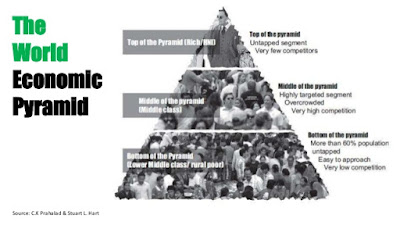Usually when I start my CRM course, we first think of consumers as those that the students making up the class can most identify with. One assignment that has been ongoing for the last 5 years is attending and observing consumers at the annual Coffee and Chocofest. This was not overlooked this year, however, as timing would have it my former student, Hira Wajahat Malik, was returning to Zagreb and came into the class (11 Feb 2016) to talk about her customer. This customer was in stark contrast to coffee addicts and chocoholics the new group of students would soon engage with but represented the Bottom of the Pyramid.
I posed to the students a question: "Do you think you will ever have to understand a new customer in a new market?" Well, ofcourse I expected them to quickly answer yes but this opened them to unfamiliar territory that Hira would expose them to over the next hour and into a week long homework assignment. The classroom went from just a few people familiar with the "BoP" term to 30 plus students diving deep into related issues --- what organizations and enterprises address customers at the Bottom of the Pyramid and how?.
Hira had spent a semester back in 2010 at ZSEM as part of an exchange program between her school in Pakistan and ours here in Croatia (www.zsem.hr). She took my Entrepreneurship course and worked on a business plan on developing a solar energy company. To every teacher's dream, she is working on a related business today and was in Europe to participate on a training and partnership exploration. She captured students by the way she matter of factly talked about how over 60% of the 220 million people living in Pakistan is off grid. But her view of the Bottom of the Pyramid showed people living with mobile phones without access to electricity and sanitation but with desire for quality products and less means to demand them. Her solution was to illustrate the isolated areas that would need more alternative energy solutions like solar energy and bringing different payment options to make it more affordable.
The students then had the challenge to find other organizations addressing Bottom of the Pyramid issues and document this with a video or article link. The assignment took anywhere from 30 seconds to 60 minutes as the students later revealed. The issues they found were related to health, hygene, access to water, women's issues, preserving cultural heritage, economic development. We had a total of 30 out of 32 students engage with this optional task. We also then challenged students to prepare a creative presentation of their short research with little guidance and a lot of freedom. Again this was optional and we got 6 assignments as a result. The 20% of the students that were willing, able and interested in pursuing this last task included poems, collages, comparitive presentations on prezi. In a future blog post update we will cluster the research the students around customer profiles, themes and locations and begin to profile their work here as some will develop them into full business cases for a graded element of the course.
 | |||
| Guest Lecturer, Hira Wajahat Malik, Teaching Assistant, Nina Alvir and students | working in the class. |










